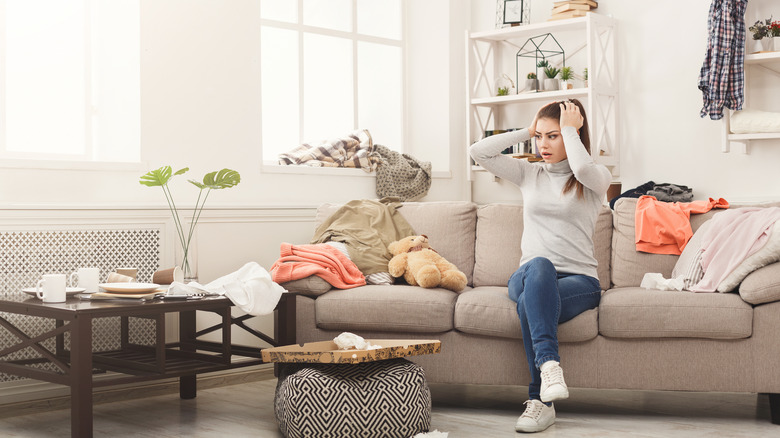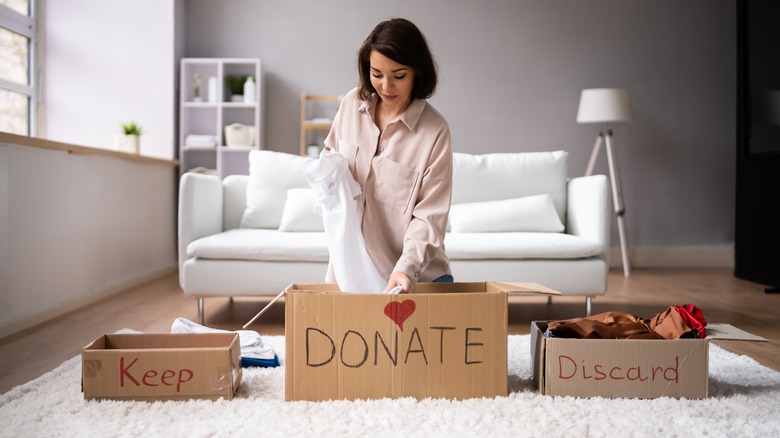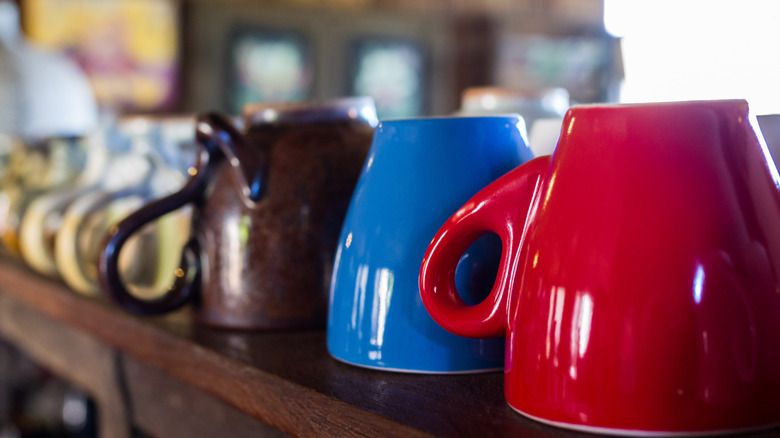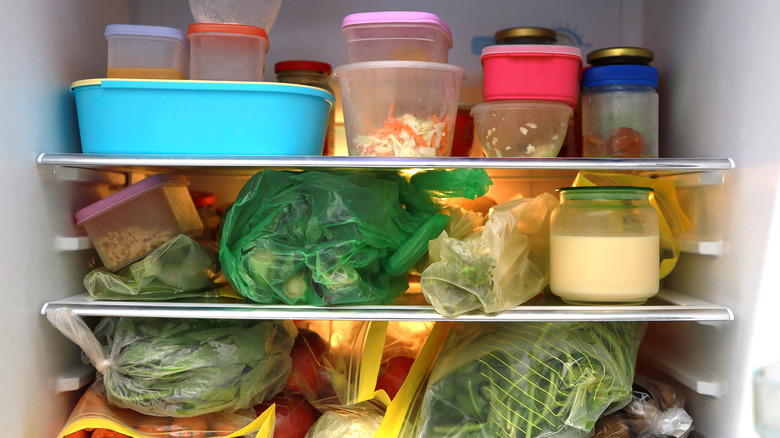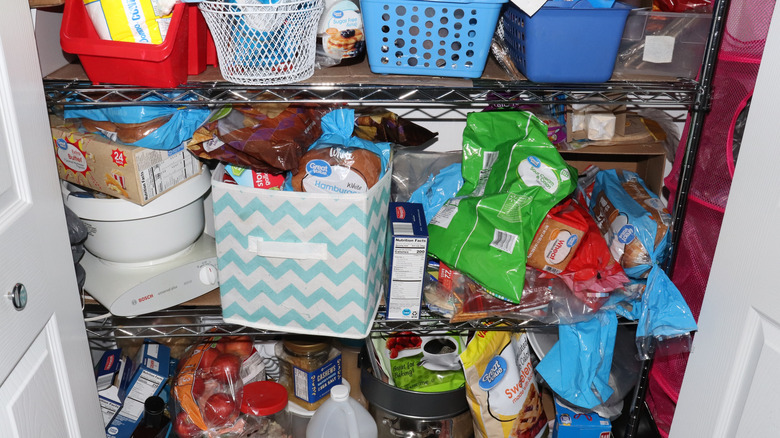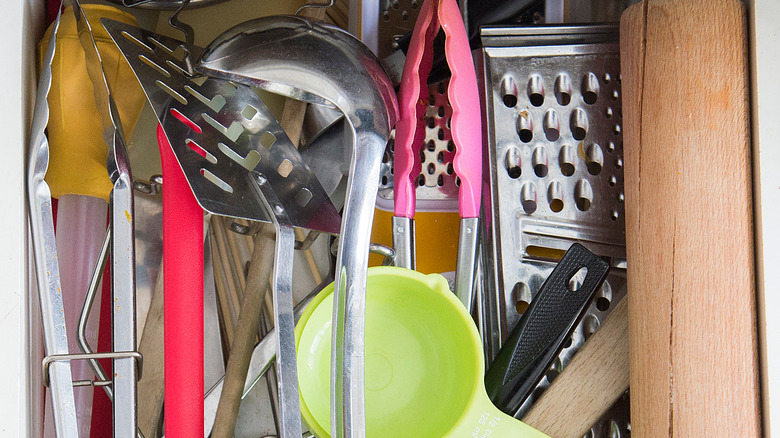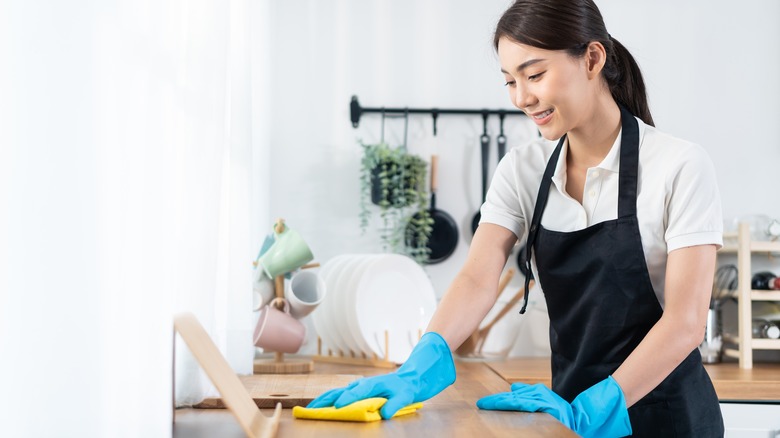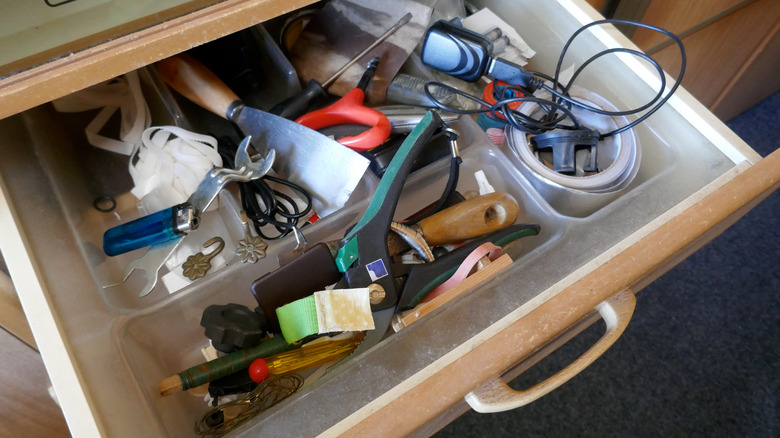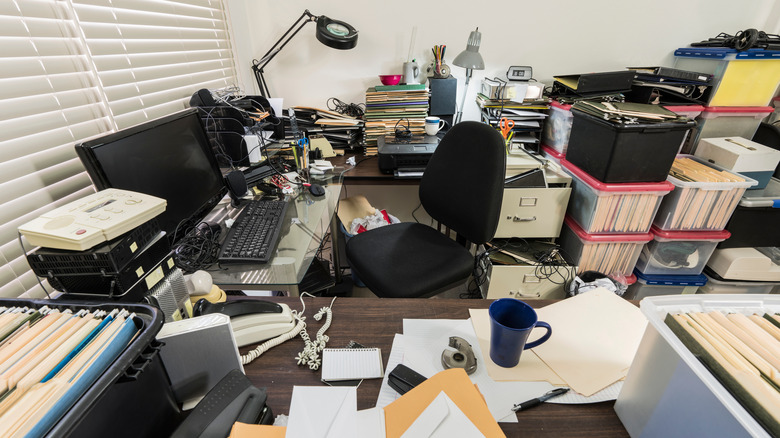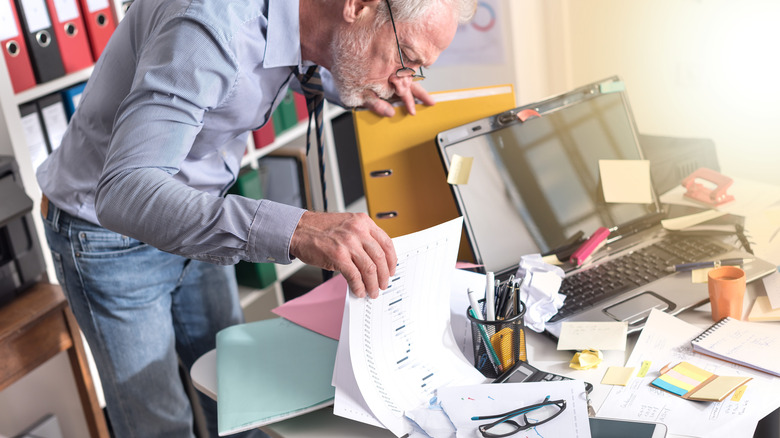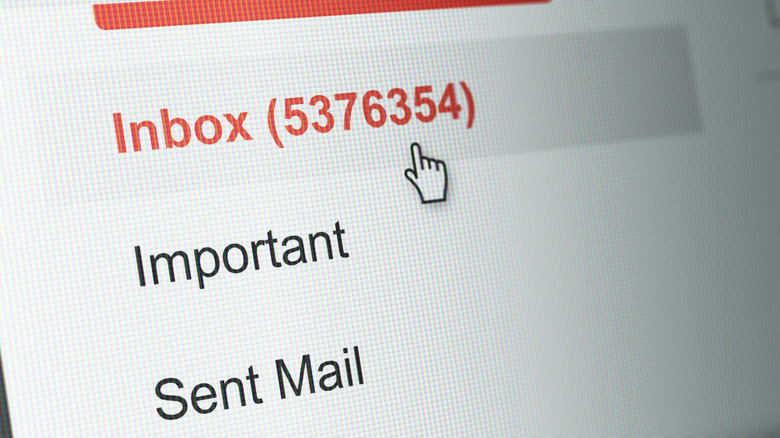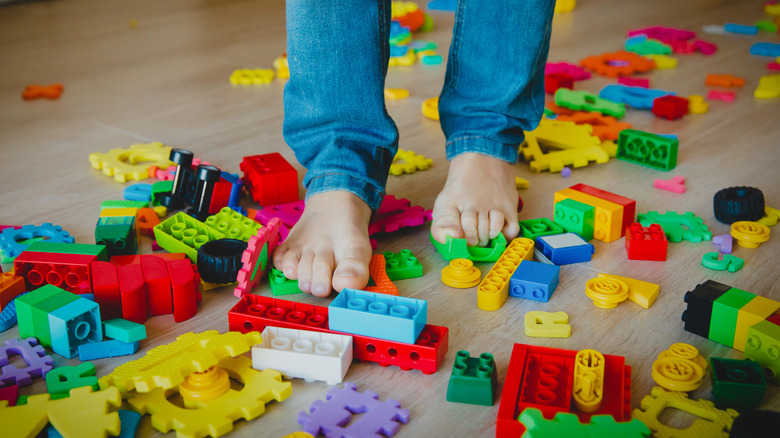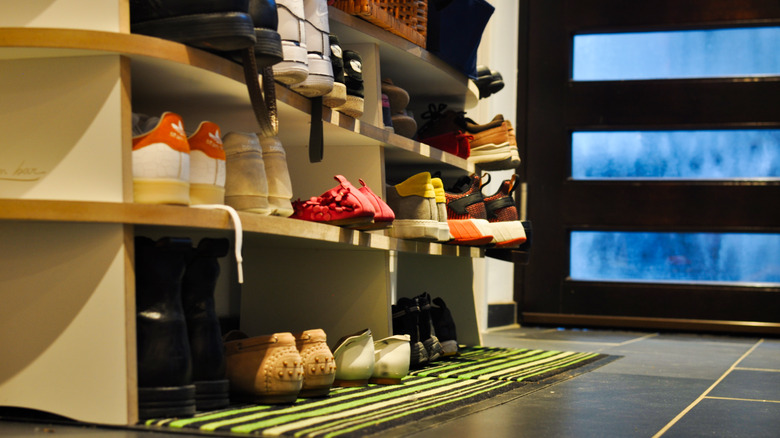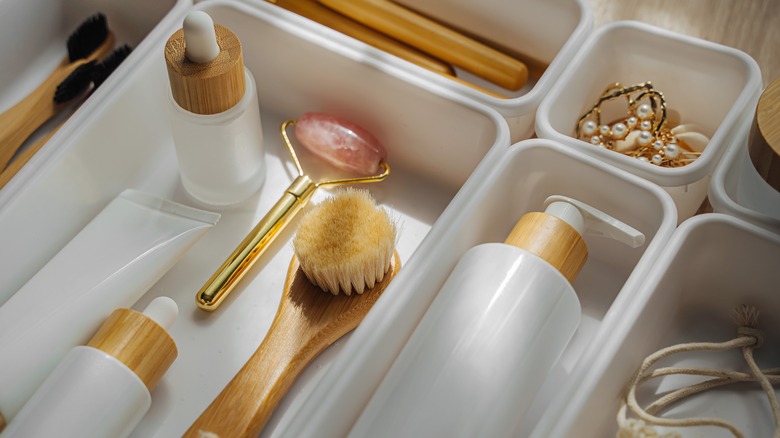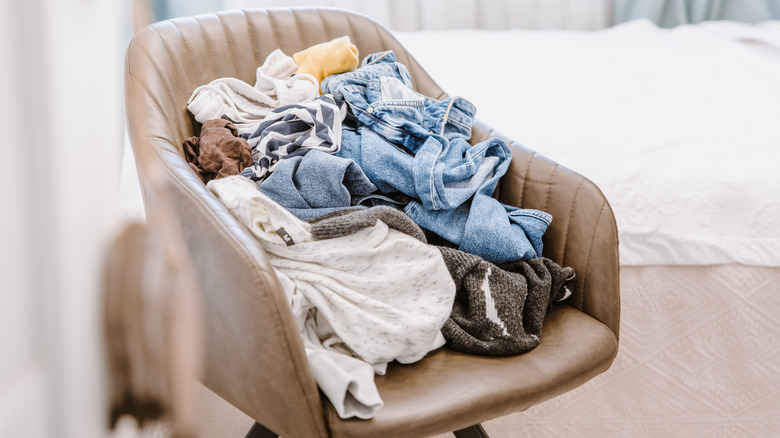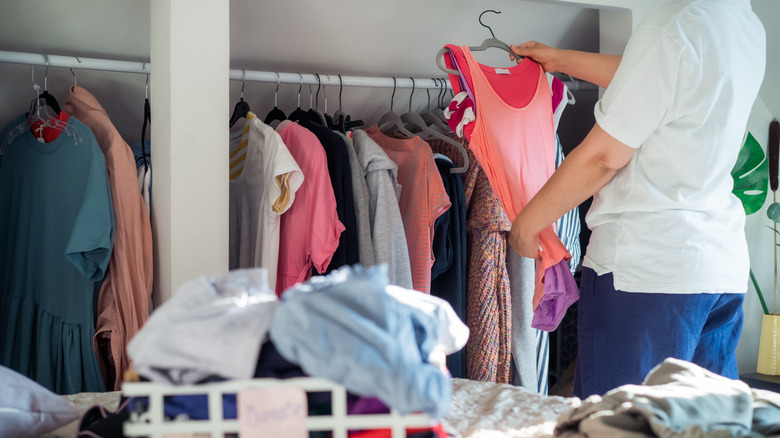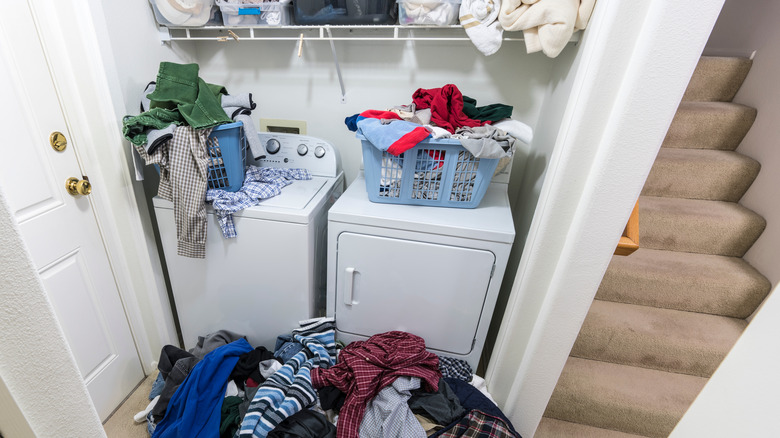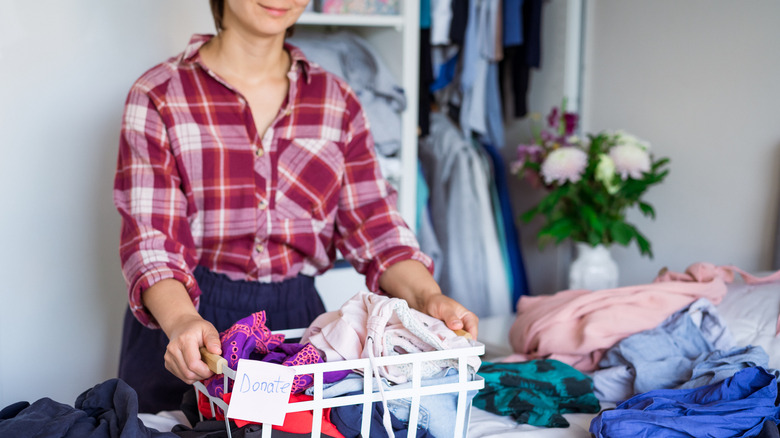Quick And Easy Decluttering In Less Than 10 Minutes
Clutter adds up fast. Whether it's junk mail on the counter, overflowing mugs in your cabinet, or expired salad dressing in your fridge, we all have unneeded items filling up our homes. According to Becoming Minimalist, decluttering can help you reduce stress, clean less because your space is more organized, and help you save money because you'll be motivated to not buy more than what you need. WebMD says a decluttered home can help you feel more focused and productive because you're not surrounded by the chaos of clutter. They advise not beating yourself up comparing your space to others; instead, take pride in your home and your commitment to making it the best it can be.
While it can seem like you need a full day of cleaning (or longer) to tackle these messes, getting tidier starts with simple decluttering. Begin with 10 minutes and see what you can accomplish. American Cleaning Institute recommends pacing your work by decluttering one room at a time, knowing that today's accomplishment can be tomorrow's motivation to declutter even more. Small bursts of cleaning can reap big rewards long term. Read on for tips on how to declutter your space in no time at all.
Get started with easy decluttering strategies
The key to decluttering in 10 minutes is working fast and efficiently. Simple Lionheart Life says you need to be ruthless when decluttering. Start by setting decluttering goals to keep you focused and on track. That means scheduling decluttering sessions into your day and keeping those commitments in the same way you would keep a regular appointment for work or for the doctor. Next, be consistent, making sure you declutter every day — sometimes even with more than just one 10-minute session. Incorporating it into your daily routine allows you to consistently look for items you can put away, donate, trash, or recycle. Keep a donation bag or box nearby so you can easily sort the items.
Becoming Minimalist challenges people to a 12-12-12 strategy, where you put 12 things away, donate 12 things, and toss 12 things into the trash. Need help getting started? Try the site's checklist of 101 things you can declutter in your home, including old cell phones and tech devices, party supplies, garden tools, coins, and more.
Declutter your mug collection
An easy place to start is with the mugs in your kitchen cabinets. Empty everything out evaluate what you have. The easiest ones to part with are those that have chips, broken handles, or stains, or those that have faded logos or paint. From Overwhelmed to Organized says you can keep the ones that are your favorite or that you use often, but if you haven't used a mug in more than three months, it's got to go. If no one in your household has a personal attachment to one, it can go too.
Make sure everyone in your household gets the chance to claim their favorites, that way you don't accidentally donate your spouse or child's preferred hot beverage cup. (Unless, of course, you hate the mug and want to get rid of it purposely — but that's begging for an argument!) Next, figure out how many mugs you need for your family and guest when you entertain. If you have sentimental mugs that you don't use regularly, consider moving them to another room as decor.
Tidy the inside and outside of your refrigerator
This one is pretty satisfying to tackle. Set a timer for 10 minutes if you need to, but otherwise just reach in the fridge and start throwing out old produce, expired condiments, and anything else — like leftovers — that you know has been in there too long. Simple Life of a Lady advises looking at expiration dates and also getting rid of items that may not yet be expired, but have been already open for a long time. Digital Trends recommends decluttering your fridge every week. Just choose a day, like trash day, and consistently throw out expired stuff and anything you won't eat. If your 10-minute timer hasn't gone off yet, do a quick declutter of your freezer too. Old meats and improperly stored items with freezer burn can be trashed. (We see you, half open box of waffles that's not closed properly!) If you have a few extra minutes, tidy the outside of the fridge too, such as magnets and notes on the front and sides, and out of reach items on the top.
Regular refrigerator decluttering could save you money, too. According to Good Housekeeping, the average family wastes up to $600 in spoiled food every year. Plus, Simple Life of a Lady says a decluttered fridge allows you to easily find what you need, which means you'll potentially save on your electricity bill because you won't keep the door open for a long time.
Pretty your pantry by getting rid of clutter
While a full pantry cleaning takes more than 10 minutes, you can still get a lot of work done in that short amount of time. Start by looking at expiration dates on all cans and stored items, like crackers and chips. Get rid of anything that's out of date or that you no longer want. Set anything aside that you would like to donate, provided it's in good condition and well before the "best if used by" date. Use a cloth or disinfecting wipe to remove crumbs from the cabinet. That will both tidy the space and prevent insects and critters (via The Simplicity Habit).
Get Organized Wizard suggests grouping like items together — such as all of your canned goods — in one space, and all of your spices in another. That way they are easy to find and you will be able to see items that are running low, or those you have duplicates of. Keep the pantry tidy by doing a monthly declutter.
Tackle the kitchen one drawer or cabinet at a time
The kitchen is definitely too large a space to organize in just 10 minutes, but you can tackle some meaningful smaller kitchen organization projects in that time. For example, Realtor.com suggests inventorying all of your utensils, including forks, spoons, and knives, as well as miscellaneous kitchen items like tongs, ice cream scoopers, paring knives, and more. Store like items together, such as slotted spoons, wooden spoons, or spatulas. That way they will all be in one place when you need them. You'll also know which items you have too many of.
Trash or donate the excess tools you don't need or use. "We have this simple rule that makes sense for most clients. For example, if my client cooks frequently and she hasn't used a utensil in a year, then we donate it," professional organizer Amy Bloomer of Let Your Space Bloom told Realtor.com. "For clients who don't cook that often, I'll use a two-year rule instead."
Declutter the countertops for a tidy space
Countertops and other flat spaces can quickly get overrun with clutter. Hello Magazine suggest clearing off the counters and tables, and making them look nice so they won't become clutter magnets. For example, set the dining table with place settings and a centerpiece. The finished look will hopefully deter you and others from filling the space with clutter.
Dinner Mom emphasizes that some items, like offie supplies and paper clips, find a home on the kitchen counter, even though they don't belong there. Set those items aside so they can be moved to a more appropriate area, like the home office. Often papers and mail are dropped off in the kitchen, which can be inconvenient and messy. If there's no other place in the house to store them, she suggests keeping them in a magnetic holder on the side of the fridge that is less visible.
Get rid of junk and reclaim your drawers
Ah, the junk drawer! The catch-all spot for anything that doesn't have a home. That's the problem. Decluttering experts like Dinner Mom say the golden rule of decluttering is that every item needs to have a designated space in the house. Clean My Space recommends renaming and reclaiming the junk drawer as a utility space.
Move anything you find in the junk drawer that doesn't belong in there back to its rightful home, such as putting dental supplies back in the bathroom, or household tools like a screwdriver back in the garage, etc. Get rid of any trash or papers that need to be recycled. Make piles of what you want to keep in the drawer, such as pens, scissors, sticky notes, or tape. Wipe down the drawer and place the items you want to keep in storage containers or small organization boxes.
Declutter your home office
Whether you've been working from home during the pandemic and your home office has gotten overrun, or you're simply stressed by a messy desk, quick and consistent decluttering can help. From Overwhelmed to Organized says you can start by decluttering one drawer at a time and keep going. Throw out any garbage in the home office, and recycle/shred any unneeded paperwork. Toss out things that don't work anymore, like dried out pens or staplers that are stuck. Designate files for your paperwork such as contracts, bills, warranties, etc. Store the files neatly in file cabinets or file boxes. Stash away new paperwork into these files to prevent clutter from building up.
Consumer Reports says you can tackle cords and cables in your home office in under 20 minutes. Top tips include placing all the wall plugs into a surge protector that's stored out of sight, such as behind furniture. Wrap up long cables with velcro ties or rubber bands. Stash any cables that are mismatched or of unknown origin in a box and label it "mystery cables." Also mark the date on it, and if after about a year you haven't used any of them, take them to donate or recycle.
Eliminate that pesky paper trail
It's easy to feel overwhelmed with all the paper coming in the home. That's why The Simplicity Habit recommends going paperless and organizing your documents digitally. Change your settings to receive digital instead of paper statements, and scan any other paperwork you want to keep. Store those digital docs in folders on email or on your computer, a hard drive, or in the cloud.
Get less junk mail too so you won't have so many extra papers to sort. According to the Product Stewardship Institute, 100 billion pieces of junk mail circulate every year, which totals about 300 mailings per person. The Federal Trade Commission walks you through the process of opting out of unwanted mailings, including catalogs and credit card offers. In the meantime, rip off any identifying information — such as your name, address, and account number — from any mail and shred that sensitive info (Identity Guard). Also, shred the following every month or two: checks deposited via mobile, pay stubs, and credit card statements (after they've been paid).
Your digital life needs decluttering too
Going digital is great because you don't have all that paper to sort, shred, and recycle. But managing digital files can still be messy. Lifehack encourages managing emails by unsubscribing from emails from retailers, and changing settings on how many newsletters you receive. Delete old emails too, since they're probably just unnecessarily clogging up your inbox.
Next, check the download folder on your computer and start deleting. If you're unsure about deleting files, start by getting rid of older downloads. Wipe out old documents too. After all, you probably don't need your college reports or that outdated resume. When it comes to managing digital photos, start by deleting blurry images, duplicate photos, and any images you don't need. Then, organize your images by date and/or event, such as "Vacation 2022." Store photos in the cloud if you don't want to use space on your computer. Declutter your social media too by unfollowing or unfriending people. Chances are, you'll like your decluttered feed a lot better.
Decluttering kids' clothes and toys
It can be challenging to part with baby and children's clothing and toys. Looking at the items can be sentimental and parting with them can make you feel sad. Still, those items are cluttering your home. From Overwhelmed to Organizing says if you want to keep a few things, only keep what you have room to store. Set rules for yourself about what you will keep, such as special items like those handmade by a loved one, or an item worn for a special occasion like a baptism, a vacation shirt, a birthday outfit, or a Halloween costume. Store the saved items in a bin or box, but realize they may not hold up well over the years. Plus, remember that styles change, which is important if you're hoping the next generation will want to wear the cherished clothes you're saving now.
When it comes to decluttering toys, Abby Organizes sorts all the toys and gets rid of those that are broken, and those that she knows her kids don't play with anymore. Next, she lets the kids decide what they want to keep and what they want to donate. If there's hesitation to purge certain items, she suggests boxing up the toys in question and putting them in the garage for a fixed time, like a month or so. If the kids don't ask for the toys, it's a safe bet they forgot about them, which means the toys can be donated.
Declutter your entryway
An entryway makes a statement for your home, but if it's filled with clutter, the statement is a sour one. That's why experts suggest making an entry way a welcoming space that has minimal stuff. Blue Matter, a blog from Coldwell Banker, encourages keeping just the basics by the door. That means storing your extra shoes, coats, hats and other items somewhere else. Instead, prioritize a place to hold your keys, mail, or your bag as you enter the space.
If you have more room, consider putting in a bench for seating, and extra storage like covered bins. When decluttering, grab items like sunglasses, phone chargers, umbrellas, and other gear and stash them away in another area. (It's important that you find a home for all these items or else they'll stay in the entryway.) Be careful that the space doesn't become a drop zone for clutter. That means it's essential to sort the mail immediately and not let it crowd the entryway. Keep a recycling bin nearby so stray envelopes and paper have a place to go.
Refresh your bathroom by decluttering
A quick bathroom declutter can be very efficient. Blogger I Think We Could Be Friends advises only keeping things in your bathroom that you actually use, rather than keeping things you may use in the future. Group like items together, such as contact lens solutions, or shampoos. If you find you have more products than you want or need, toss them or donate them without the guilt. After all, keeping them in your bathroom is only adding to the problem, while purging them is a solution.
Clean and Scentsible recommends asking yourself a series of questions when evaluating what to keep and what to throw way: Is the product expired? Do I use it? Does the product help me? Do I already have an extra of the item? Would I buy it again? Consider getting rid of items like trial size products, extra towels, cosmetics, skin care products, hair products, nail products, medication, decor, cleaning products, and first aid supplies.
Sleep better in a decluttered bedroom
A decluttered bedroom looks great and it may help you sleep better too. A study of over 1000 participants published in the journal Sleep, by the Oxford Academic, concludes decluttering and self-care habits increased an individual's sleep quality and resulted in fewer problems with sleep. As we know, get a quality night sleep is so important for our overall health, so let that be a motivator to get decluttered and orgnanized.
Sleep.com says it's a good idea to take a photo of your bedroom so you can assess how messy it is, and then devise a plan of what you need to declutter. Relocate chairs, benches, and any other seats out of the room because they can make the room look messy. "Chairs in a bedroom are magnets for clutter, typically that worn-once-but-not-really-dirty category of clothing," professional organizer Sarah Giller Nelson reveals. "Keep these items on hooks behind a bedroom or closet door." Other recommendations include throwing out old receipts, food wrappers, and expired products. Put knickknacks, such as spare change, in a bowl inside a dresser. That way the items are contained and they don't look cluttered on the top of your dresser or nightstand.
Give your bedroom closet a 10 minute makeover
Decluttering your closet in 10 minutes seems impossible, and while it's not going to get the job done completely, it's a good start. Strawberry Chic recommends donating gently used clothing that's not stained or ripped, and tossing any items that are very worn or can't be reused. If you have too many of one thing, like hats or jeans, keep only your favorites and purge the rest. If you haven't worn the clothing in over a year, get rid of it. Make sure you only keep things that still fit and that you actually want to wear when you open the closet door. Clear out things that no longer fit your style, anything that isn't comfortable, or anything that makes you feel self-conscious.
While many decluttering experts tell you to take everything out of your closet before you start removing clutter, Decluttering School says that isn't the only way. Instead, look at your closet and take out the items you love — those are definitely staying. For items you're unsure about, try them on and ask yourself how well they fit, if they flatter, and consider if they're in good condition. Next ask yourself if you plan to wear it in the next six months and consider whether it works with two or more outfits currently in your closet. Donate the rest of the items that don't make the cut.
Sort your clutter before sorting your laundry
Laundry rooms may be the place to clean things up, but they also have a fair share of clutter. Simple Life of a Lady encourages people to only keep what they really need, which helps keep laundry rooms, which typically are small rooms, tidy and presentable. Toss cleaning products that you no longer use or that you don't like, recycle old soap bottles, and throw out old or broken hangers.
Since this is a smaller space, you may have extra time to tidy up. If so, start by cleaning out the lint trap in your dryer, sweep away any dust, and vacuum as needed. You can also rinse your washing machine with 2 cups of vinegar on a hot water cycle. Next, store items you don't use often on the top shelf and put frequently used items on lower shelves so they're easily accessible.
What to do if you're unsure about what to keep, purge, or donate
Struggling with certain items, such as something sentimental, and can't decide if you're done with an item? Simple Lionheart Life recommends creating a "maybe" box where you place items you are unsure about purging. Stash the maybe box away for a few months to give yourself time to decide if you really want to keep what's inside.
Sixty and Me calls this the "dilemma box," and advises marking a date on your calendar to check back to see if you missed the items or need them in any way. Go a step further by asking a friend to hold onto the dilemma box. When it comes time for the friend to open it for you, you can keep any item in the box that you can identify. This is definitely the tougher option, but it will force you to decide what to keep and what to purge. After all, holding on to stuff you don't need is the whole reason you need to declutter.
Preventing clutter going forward
One strategy to prevent clutter is to have a "one in, one out" policy. That means whenever you buy a new item, you get rid of another item. For example, when you buy a new shirt, donate an old one to charity (via The American Cleaning Institute). This strategy can be tough to adhere to, but it'll keep your home tidier, and potentially more organized.
The Simplicity Habit recommends storing items in appropriately-sized containers to prevent clutter. Here's why: If the bin is too small, you won't have enough room to hold what you really need to store; and if it's too big, you'll be tempted to fill it with more items, which can lead to more clutter. Another tip offered is to avoid keeping free items, including buy one get one free offers or free items found online. Unless you're planning to use the item right away, you probably don't really need the item, because, long term, it will just become clutter.
